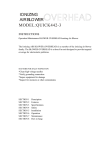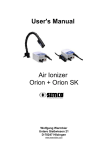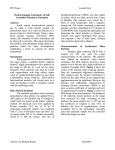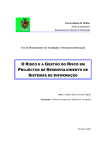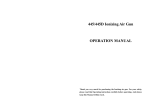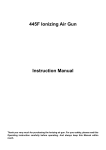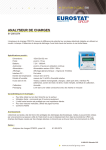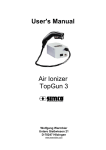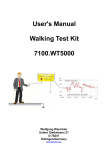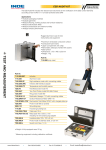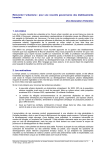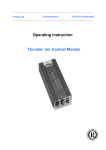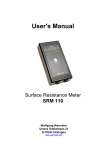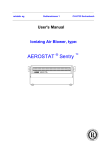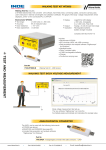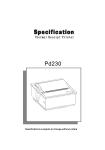Download MODEL:QUICK442 IONIZING AIR BLOWER
Transcript
IONIZING AIR BLOWER MODEL:QUICK442 INSTRUCTIONS Operation/Maintenance BLOWER OVERHEAD Ionizing Air Blower The Ionizing AIR BLOWER (OVERHEAD) is a member of the ionizing air blower family. The BLOWER OVERHEAD is a two-Fan unit designed to provide targeted coverage for electrostatic problems. MATTERS FOR DAILY INSPECTION *Clean high voltage needles *Verify grounding connection *Inspect equipment for damage *Inspect for moisture or other contaminates SECTION 1 SECTION 2 SECTION 3 SECTION 4 SECTION 5 SECTION 6 SECTION 7 Description Features Specifications Safety Installation Operation Maintenance SECTION 1 Description The BLOWER OVERHEAD ionized air blower produces an air flow that is rich in positive and negative ions. Directing the air flow on an object that has a static electricity charge will neutralize the charge. If the object has a negative static charge, it will draw positive ions from the air flow. Conversely, if the object has a positive static charge, it will draw negative ions from the air flow. The air ions are attracted to the oppositely charged object and neutralize the change on the object. The BLOWER OVERHEAD is a portable ionized air blower. It uses two small fan to produce air flow, The volume of air flow is controlled by variable speed control which provides a wide range of air flow settings. The low wattage heating element can be turned on at any time for user comfort. The ionizing elements are energized with a low current, high voltage transformer. The transformer contains a current limiting resistor which enhances ionization stability and provides for safety. The high voltage AC is applied to a circular arrangement of stainless steel ion emitter points which results in an intense alternating electric field at the tip of the emitter points. It is this electric field that creates alternating polarity air ions in the air flow. To assure that the unit is working properly, the high voltage AC is monitored by an ionization indicator lamp. The ionizer of the BLOWER OVERHEAD features a patented balancing circuit. Using the point cleaner takes only seconds. Cleaning the emitter points on a weekly basis prevents the build-up of airborne debris all electrical ionizers are prone to. This keeps your BLOWER OVERHEAD working in top form for the life of the unit. The BLOWER OVERHEAD was designed for use with sensitive electronic components, where electrostatic discharge is a problem. The BLOWER OVERHEAD can also be used where static electricity causes problems such as: attraction of dirt to product, misalignment of small parts due to electrostatic “jumping” and undesirable adhesion of plastic films due to electrostatic charge. SECTION 2 Features * Rapidly neutralizes static charges. * Design with each other independent two air blowers. * Ion balance adjustable. * Covers an extended distance and large area coverage with ionized air. * Variable speed fan with wide range of air flow. * Integrated task lights (9 watt twin tube) * Inherently balanced ion output. * Expediently ion emitter cleaner. * Ionization indicator lamp. * Durable, electrically grounded metal enclosure. * Hanging installation and economize space greatly SECTION 3 Specifications Unit Part Number: OVERHEAD-120VAC Line Voltage: 120 VAC 60 Hz Current Draw: Max. 2 Amp Air Volume Output: Air Velocity Air Flow Characteristics: Fan Speed Low High OVERHEAD-230VAC 230 VAC 50Hz 1 Amp Flow 2*35 CFM 2*70 CFM Fan Speed 1ft. 2ft. 3ft. 4ft. Low 250 200 150 125 High 500 400 300 250 Velocity in FPM measured at center line of air stream 21/2’ x 5’ Area Coverage(750mm×1500mm) Operating Temperature: 32℉(0℃) 122℉(50℃) Ozone Production: 0.01 ppm measured 6’’in front of unit, fan low. Audible Noise: Fan Speed Low 45dB High 50dB Measured 2 ft. from unit. Enclosure: Steel Finish: Acrylic Enamel Weight: 7.0 kg Size: 63 cm(L) x 9.0 cm(H)x17 cm(W) Bench Stand Feet: Nonconductive, Nonstaining Polymer Optional Air Filter: Ion Balance (offset voltage): 30 PPI Open Cell Polyurethane Foam OV ±15V Lamp: Ion Output(discharge time: S) 300mm 9 watt twin tube 300mm Tp1 5.5 300mm tp5 8.5 300mm tp9 11.0 tp13 15 300mm Tp2 1.5 tp6 3.5 p10 7.0 tp14 11.0 300mm Tp3 1.5 tp7 3.5 tp11 7.0 tp15 11.0 300mm blower Tp4 5.5 tp8 8.5 tp12 11.0 tp16 15.0 1. Offset voltage and discharge time determined as per ESD Association Standard No. 3 using 6’’ x 6’’, 20pF plate(charged plate monitor). 2. Discharge times are in seconds from 1000 volts to 100 volts at locations shown. 3. Above testing value can be changed with difference of temperature, humidity and ambient environment Note: Discharge times for high speed are 10% longer for 230 v, 50Hz. SECTION 4 Safety 1. Read instruction manual before installing or operating device. 2. This unit is equipped with a 3-prong grounding plug and must be plugged into a 3-terminal grounded receptacle. Do not defeat the grounding by modifying the plug or using an ungrounded 3-prong adapter, If an extension cord is necessary, use only a 3-wire extension cord that provides grounding. 3. Do not insert objects through intake or outlet grille. 4. Do not operate unit in flammable or explosive atmospheres. 5. Internal repairs or servicing must be done by qualified personnel. SECTION 5 Installation The BLOWER OVERHEAD is designed for permanent operation. The overhead blower can be used in permanent operation by hanging it to a sturdy flat surface such as a wall or under a shelf. For extremely dirty environments, an optional air filter may be installed. The air filter consists of a filter retainer and an air filter element. The BLOWER OVERHEAD should be placed approximately 1 to 3 feet from the critical work area or objects to be neutralized. It should be positioned to cover as much of the area as possible with the ionized air stream. The BLOWER OVERHEAD, part number OVERHEAD-120VAC, requires 120 VAC 60 Hz for proper operation. The unit must be grounded for safe operation. Plug the unit into a standard 3-terminal grounded receptacle. If an extension cord is necessary, use only a 3-wire extension cord that provides grounding. The BLOWER OVERHEAD, part number OVERHEAD-230VAC,requires 230 VAC 50 Hz for proper operation. The unit must be grounded for safe operation. The unit comes with line cord, without plug. A plug must be installed on the line cord for operation. Installation of the plug must be performed by qualified personnel. The color code for wiring the plug is as follows: Brown – Line; Blue – Neutral; Green/Yellow – Ground. Under the unclean environment, please set the filtration attached. This filtration includes a fixture and a carbon filter. Put the carbon filter inside the fixture, then fix the fixture to the plastic shield. Press down the edge of fixture slightly, so that the fixture will be locked in. Note: Make figures of the fixture and the shield superposed. Keep the arrowhead adown. SECTION 6 Operation Put the plug of power into the socket and turn on the power switch, the air blower start working. Activate the BLOWER by turning the FAN SPEED knob clockwise. The IONIZATION INDICATOR will illuminate to indicate the presence of ionized air. Set the air flow as desired by adjusting the FAN SPEED knob. To clean the ion emitter points, rotate the POINT CLEANER knob clockwise to the stop (approximately one turn) and release. Turn on the lighting switch if need. The BLOWER OVERHEAD produces an ionized air stream that covers a targeted area. The time required to neutralize a static charge on an item in the air stream depends on many factors. Two important factors are: distance to ionizer and air velocity. Air ions constantly “neutralize” each other. Positive and negative ions are statically attracted to each other. When they contact, the charge transfers and the ions “recombine”. With high air velocity, the air ions travel further before they “recombine”. Setting the fan speed as high as acceptable results in more rapid neutralization. For fast neutralizing, the item should be held within 1 to 3 feet from the BLOWER. When using the BLOWER in an electronics assembly area, the ionized air stream should cover as much of the work area as possible. Charged items introduced into the work area will be neutralized and will remain neutral while in the ionized air stream. SECTION 7 Maintenance The BLOWER OVERHEAD has been designed with low maintenance in mind. The only regular maintenance suggested is emitter point cleaning, ion balance checking and ion output checking, Emitter point cleaning takes only seconds with the patented point cleaner. The BLOWER OVERHEAD contains an patented balancing circuit that is inherently self balancing. This circuit compensates for dirt build – up on emitters, emitter point wear, line voltage fluctuations and variations in air velocity. Scheduled checking of the ion output and balance should be considered to assure quality audit requirements. Emitter Cleaning To clean the ion emitter points: simply rotate the point cleaner knob located at the center of the outlet grille clockwise to the stop (approximately one turn)and release, The spring loaded point cleaning brush will return to its parking spot. Recommended frequency of cleaning is once a week. Air Inlet and Outlet Cleaning The air inlet grille on the rear of the unit and the ionized air outlet should remain clean to prevent restriction of air flow. They can be cleaned with a soft brush or vacuum. Air Filter Cleaning Remove the air filter from the rear of the unit by unsnapping the filter retainer. Rinse the filter in plain water while gently squeezing. If the dirt is stubborn, wash the filter in mild soap and water then rinse. Blot the filter dry with paper towels and allow to dry. Install filter on air inlet and secure by snapping the filter retainer in place. IMPORTANT: If an air filter is used, clean the air filter regularly. Ion Output Check To test the unit for ion output the use of a charged plate monitor is recommended. Discharge times can be measured and checked against the Ion Output tables in Section3, Specifications. If a charged plate monitor is not available, but a static meter such as a SIMCO handheld electrostatic field meter SHISHIDO electrostatic Analyzer or warmbier charged plate monitor is available, ion output may be checked with the following procedure. Take a piece of plastic and rub it with cloth until a static charge can be read with the static meter. Turn on the BLOWER OVERHEAD and set the fan speed to high. Hold the plastic one foot away from the ionized air outlet for five seconds. Remove the plastic from the ionized air stream and measure the static charge. The plastic should be neutralized. If no instrumentation is available, the unit’s operation can be verified with the following procedure. Tear-off about a 10 inch length of transparent tape. Approach the nonadhesive side of the tape with your free hand note the electrostatic attraction of the tape to your hand. Pass the tape through the ionized air stream approximately 1 foot from the unit and again approach the nonadhesive side of the tape with your free hand, If the tape has been neutralized, it will not attract. CAUTION! ELECTRICAL SHOCK HAZARD – Do not insert objects through intake or outlet grille. Do not try to verify operation of the unit by drawing a spark from an ion emitter point. The design of the balancing circuit makes the “spark test” inconclusive. Sustained grounding of the ion emitters may damage the balancing circuit. Ion Balance Check To test the unit for ion balance, the use of a charged plate monitor such as the SIMCO Electrostatic Analyzer H0601(SSD) or cpm374(Warmbier) is recommended. Offset voltage should be measured and checked against the Ion Balance in Section 3, Specifications. Testing value can be changed with difference of temperature, humidity and ambient environment. Do not try to determine ion balance by holding a static meter in the ionized air stream. This will result in s meaningless reading. Ion balance adjustment This Blower is designed with function of ion balance adjustment. If the offset voltage (ion balance deflection) is too much, you can adjust the ion balance. Use the screwdriver to adjust the balance localizers back of the unit respectively. When ion balance lean to positive, adjust clockwise. Adjust clockwise to produce negative ion; When ion balance leas to negative, adjust anticlockwise. Adjust anticlockwise to produce positive ion. NOTE: The two fans are adjusted at the same time when adjusting the ion balance. Calibration The BLOWER OVERHEAD’s ion output is inherently balanced by design. If, after adjusting the ion balance, the offset voltage is still too much ,please contact our Customer Service. SECTION 8 How to hang










